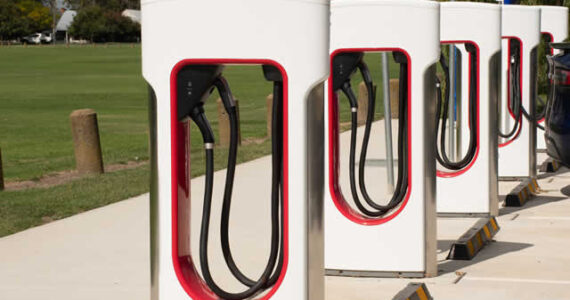The rise of electric vehicles (EVs) is transforming the global transportation sector, drawing significant attention to the infrastructure essential for their success. EV charging stations are a critical component of this shift, ensuring that drivers can power their vehicles conveniently and reliably.
But with the current EV adoption surge, many wonder if the charging station infrastructure is expanding quickly enough to meet demand.
Will we see more charging stations installed in the near future? And, with limited availability in certain areas, how can EV owners best plan their journeys?
This article will explore the state of EV charging stations, factors propelling their growth, future advancements, and practical advice for drivers navigating today’s environment.
Current State of Charging Stations
The current landscape of EV charging stations is both promising and, in some ways, challenging. On one hand, the number of charging stations globally has surged in recent years, reflecting growing demand for sustainable transportation. However, gaps in geographic coverage and challenges with accessibility remain prevalent.
The total number of charging stations has grown considerably, with tens of thousands of public chargers now available across the United States. Nonetheless, distribution is an ongoing issue.
While urban areas boast a higher concentration of chargers, rural and less-populated regions often have limited infrastructure, creating "charging deserts" that pose challenges for EV drivers traveling long distances.
Charging stations also vary in type and functionality. There are three primary kinds of stations:
- Level 1 chargers provide basic, low-speed charging, suitable for overnight use at home.
- Level 2 chargers deliver faster charging, making them popular for residential, workplace, and some public locations.
- DC Fast Charging stations offer rapid recharging, allowing EV owners to significantly replenish their battery within minutes. These are ideal for highway access points or rest stops on long trips.
While progress is undeniable, issues with charger availability, scattered infrastructure, and compatibility across different EV brands can hinder a seamless charging experience for drivers. The ability to address these challenges effectively will determine how smoothly the EV revolution unfolds.
Factors Influencing the Growth of Charging Stations
Several driving forces are contributing to the expansion of EV charging stations, firmly aligning with the ongoing shift toward electrified mobility. These factors encompass government support, technological advancements, private sector involvement, and evolving consumer demand.
Government policies have been instrumental in shaping the growth trajectory for EV infrastructure. Incentives like tax credits, grants, and subsidies have encouraged companies and local authorities to invest in charging station installations.
Furthermore, infrastructure development programs, such as the US government’s Bipartisan Infrastructure Law, have allocated billions of dollars toward building a nationwide EV charging network, prioritizing underserved areas and highways.
Advancements in charging technology are also propelling the industry forward. Innovations such as ultra-fast charging, increased battery capacity, and wireless charging systems are making EV ownership more convenient and accessible.
These developments not only improve user experience but also address range anxiety, a major obstacle for prospective EV buyers.
Private sector investment plays a significant role, with automakers and energy providers heavily investing in charging solutions.
Companies like Tesla, ChargePoint, and Electrify America have been at the forefront of installing charging stations, often in collaboration with governments and private businesses. This partnership-driven approach helps scale charging networks more effectively.
Lastly, rising consumer adoption of EVs is a key catalyst. With EV sales climbing annually and battery costs decreasing, demand for reliable charging solutions continues to grow. More drivers on the road with EVs equate to a greater need for accessible infrastructure, further driving investment and innovation in the sector.
Future Projections
The future of EV charging stations looks highly optimistic, with significant growth expected in the coming years. Analysts predict exponential increases in the number of available stations, with global installations potentially doubling or tripling over the next decade. While this progress is encouraging, strategic planning and continued investment will be essential to prevent gaps in coverage.
New business models are also emerging to meet consumer needs. Subscription-based charging services, for instance, offer drivers convenient access to member-only networks of charging stations. Such models aim to enhance user experience while ensuring network profitability.
Another exciting prospect is the integration of charging stations with renewable energy sources, such as solar or wind power. These sustainable solutions minimize the environmental footprint of EV infrastructure, aligning perfectly with the broader goals of achieving cleaner mobility and reducing greenhouse gas emissions.
Smart charging technology will also play a pivotal role moving forward. These systems leverage artificial intelligence and grid-connected solutions to optimize electricity use, balancing demand peaks and ensuring efficient energy distribution.
By integrating EV chargers into a larger smart grid ecosystem, charging infrastructure can become more reliable and sustainable.
Navigating the Road With Limited Charging Stations
Even with continuous improvements, gaps in infrastructure may persist in the short term, leaving EV drivers to plan ahead to ensure smooth and stress-free journeys. For those traveling through areas with limited charging options, a few strategies can help.
Effective trip planning is crucial to avoid unexpectedly running out of battery power. Tools like Google Maps, Tesla’s trip planner, or specialized apps like PlugShare can identify charging points along your route. These platforms also provide additional data, such as the type of charger available and whether it is currently occupied.
Utilizing charging station finders is another valuable tactic. Platforms such as Electrify America and ChargePoint have robust apps to help users locate their network of chargers, add payment options, and track station availability in real time. These tools make it easy to build charging into your travel schedule.
When charging on-the-go, adopting best practices can save time and eliminate inconvenience. For example, maximizing battery use by regulating speed or limiting unnecessary air-conditioner usage can improve range. Additionally, taking advantage of faster DC chargers at highway stops reduces downtime during long trips.
By following these strategies and leveraging available resources, EV drivers can overcome charging challenges and confidently take to the road.
Preparing for the EV Future
The road ahead for EV charging stations is one of rapid growth and innovation, but it still presents challenges that need addressing. From enhanced government support and technological advances to consumer and private investment, the pieces are falling into place for a robust, sustainable charging infrastructure.
While EV drivers may currently face hurdles with availability and accessibility, improvements are expected to accelerate, shaping a future where charging is as seamless as filling a gas tank.
For those seeking to learn more about EV technology and infrastructure, there’s never been a better time to get involved in the conversation.
Whether you’re an EV owner, a sustainable energy enthusiast, or an investor in green tech, staying engaged with this evolving topic is essential. Together, we can drive the industry forward toward a cleaner, greener future.
image credit: envato.com


















